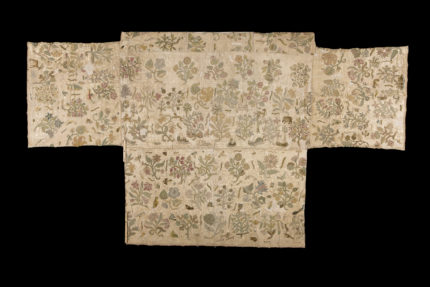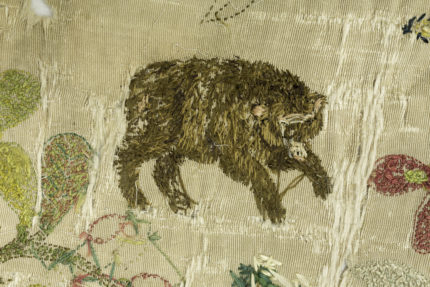
After three years of study and conservation, the Bacton Altar Cloth is going on display at Hampton Court Palace. None of Elizabeth I’s clothing has survived, although a number of accessories have, so this cross-shaped piece is uniquely rare.
The embroidered silk textile was donated to St Faith’s Church in Bacton, Herefordshire, by Blanche Parry who was one of Elizabeth’s most loyal and dedicated ladies. She served the future queen starting during the reign of Henry VIII when Princess Elizabeth was a young girl and continued uninterrupted for 57 years, reached the exalted rank of Chief Gentlewoman of Queen Elizabeth’s most honourable Privy Chamber and Keeper of Her Majesty’s jewels. The queen is known to have given Blanche clothes she longer wanted.
While there is no specific record of this particular textile being a royal hand-me-down, its materials and manufacture are so exquisite that it would have been literally illegal for a non-royal to wear such a garment. A monarchical provenance would also explain why Blanche considered the piece important enough to donate to her hometown church where her heart is also buried.
The altar cloth’s connection to Elizabeth I has been rumored for centuries. Recognizing its importance, in 1909, the church took it off the altar and placed it in a glass display case. In 2016, St. Faith’s asked Historic Royal Palaces to study the altar cloth.
On examining the textile, [Historic Royal Palaces curator Eleri] Lynn – an expert in Tudor court dress – was able to identify previously unseen features, studying the seams of the fabric to confirm it had once formed part of a skirt.
Following the exciting discovery, Historic Royal Palaces – the independent charity that cares for Hampton Court Palace – agreed to commence a conservation programme to stabilise the fragile fabric in the palace’s world-class textile studio. Further examination of the cloth by experts has added weight to Lynn’s theory that it might once have belonged to the Tudor Queen. Its creation from high-status silver chamblet silk, use of professional embroidery including real gold and silver thread, and distinct evidence of pattern-cutting all suggest that the item could have formed part of Elizabeth’s lavish wardrobe. The conservation team were also able to test the dyes within the fabric, discovering that it contained expensive Indigo and red dye sourced from Mexico – the kind of materials only available to a person a very high status.
The embroidery is truly spectacular, a profusion of flora (columbines, daffodils, roses, honeysuckle, oak leaves, acorns, mistletoe) and fauna (peacocks, other birds, frogs, dragonflies, butterflies, caterpillars, fish, dogs, dear, squirrels, a crocodile, a bear). There are also small wooden boats being rowed by tiny embroidered people.

The exhibition will delve further into the use of these motifs in the Tudor era. One of the most important works on display, and one of the most significant pieces of circumstantial evidence for the altar cloth having been part of one of Elizabeth’s gowns, is the Rainbow Portrait (c. 1600 – 02), attributed to Marcus Gheeraerts the Younger. It depicts Elizabeth in an embroidered silk gown with very similar imagery. It is being loaned from Hatfield House for the exhibition and this is the first time it will be on display at Hampton Court Palace.
Accompanying the painting will be a selection of rare domestic print books dating from the Tudor period, which would have provided inspiration for many of the embroidered motifs fashionable during Elizabeth’s reign – including those found on the Bacton Altar Cloth – brought together for the first time with other stunning embroidery work from the period.
The Bacton Altar Cloth will be on display from October 12, 2019, until February 23, 2020.